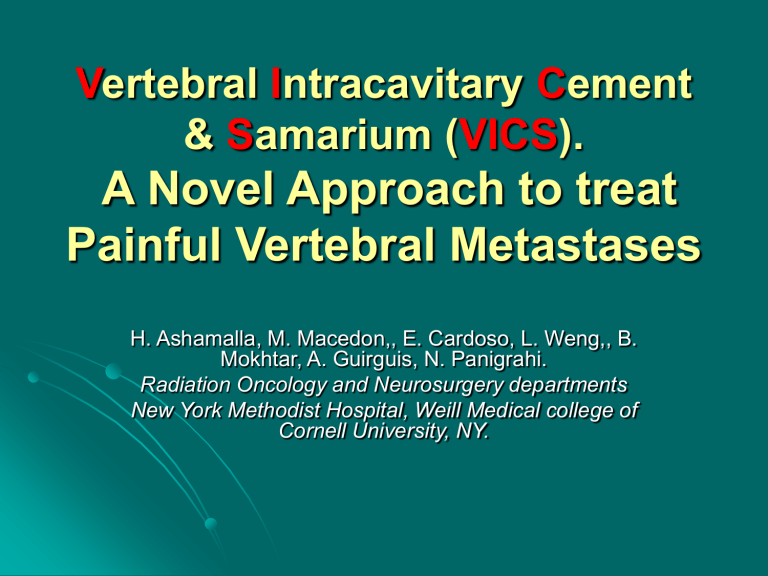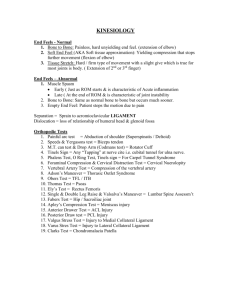open "500854_ASTRO_POSTER_2008"

V
ertebral
I
ntracavitary
C
ement
&
S
amarium (
VICS
).
A Novel Approach to treat
Painful Vertebral Metastases
H. Ashamalla, M. Macedon,, E. Cardoso, L. Weng,, B.
Mokhtar, A. Guirguis, N. Panigrahi.
Radiation Oncology and Neurosurgery departments
New York Methodist Hospital, Weill Medical college of
Cornell University, NY.
Background
Each year, more than 100,000 patients in the U.S. develop bone metastases.
Bone is the third most common site of metastatic disease after liver and lung
Up to 40% of patients presenting with bone mets. will have spinal/vertebral mets,
90% of whom will develop severe axial pain
Metastatic Bone Disease
Epidemiology - Etiology
Breast
Prostate
Bladder
Lung
Thyroid
Other
Total
Estimated Number of Persons Living with Cancer 1
Number of New
Cases in 2004 1
2,184,125 (24%)
1,838,653 (20%)
521,945 (6%)
388,538 (4%)
217,440 (16%)
230,110 (17%)
60,240 (4%)
173,770 (13%)
273,642 (3%)
4,013,458 (43%)
23,600 (2%)
705,160 (52%)
9,220,361 (100%) 1,368,030 (100%)
Incidence of
Bone
Metastases 2
65-75%
65-75%
40%
30-40%
60%
1. SEER Cancer Statistics Review 1975
– 2001, National Cancer Institute
2. Coleman, R.E. Cancer Treatment Reviews . 2001;27:165-176.
Metastatic Bone Disease
Metastasis Sites
Most common sites of metastasis
Vertebra (69%)
Pelvis (41%)
Femur (25%)
Hip (14%)
Median time from cancer diagnosis to bone metastasis is 30 months
Vertebral Compression fractures
(VCF)-
Metastatic cancer in the bone causes skeletal complications every 3 to 4 months.
17 – 50% of patients with metastatic breast cancer will develop VCFs annually.
Median time to first fracture among breast cancer patients
(not on bisphosphonate) is 12.8 months.
Metastatic Bone Disease
Treatment Goals
Reduce pain
Eradicate or reduce tumor when primary tumors are involved
Prevent neurologic complications
Treat pathologic fractures and prevent recurrent fracture
A) Surgical Treatment
Operative Management
Vertebral column reconstruction
A or P decompression with internal fixation
Oncology patients are generally poor candidates for open surgery due to soft bone/tumor mass and co-morbidities
Minimally Invasive Procedures
Kyphoplasty
Vertebroplasty
Balloon Kyphoplasty
Patient placed in lateral decubitus position
Trochar inserted into anterior vertebral body under fluoroscopic guidence
Curretting performed for tissue sample
Balloon inflated to decompress the fracture and to open up space for cement injection
Balloon removed and PMMA bone cement injected into cavity to stabilize the vertebra
Balloon Kyphoplasty
Balloon Kyphoplasty
Shown to significantly reduce pain associated with VCF in patients with metastatic bony lesions
However, this procedure does not address the neoplastic component of the problem
B) Radiation Treatment for Bony
Metastasis
External radiation
Radionuclides – systemic administration, localize to all bony mets
Strontium-90
Samarium-153
Samarium-153
Created by bombarding Samarium-152
(stable) with neutrons
Comes from manufacturer complexed to
EDTMP
Beta particles from Sm-153 travel 3.1mm in tissue, 1.7mm in bone
Typically administered at the dose of
1mCi/kg
Samarium-153 (systemic)
When given IV, Sm-153-EDTMP (Quadramet) has an affinity for bone and will concentrate in areas of high bone turnover, especially bony metastasis
Mechanism of relief of bone pain is unknown, but may be due to suppression of the growth of the tumor cells from radiation
Major adverse effect of systemic administration is hematologic toxicity with nadir at 3-4wks:
Leukopenia 60%
Thrombocytopenia 69%
Decr. Hemoglobin 40%
V
ertebral
I
ntracavitary
C
ement and
S
amarium
{
VICS}
Procedure
Materials
Methods
V
ertebral
I
ntracavitary
C
ement and
S
amarium
{
VICS}
A novel approach to bony metastasis
Employs combination of balloon kyphoplasty and anti-tumoral activity of
Sm-153 injected directly into the affected vertebra
Objectives
Study feasibility of intravertebral administration of Sm-153 with kyphoplasty
Assess procedure-related morbidities
(specifically hematological) related to procedure
Monitor pain relief and durability of response
Eligibility
Inclusion criteria:
Documented bone mets with intact anterior wall of vertebra
Recurrent pain or progression of metastases in areas treated by prior external RT
Acceptable candidate for kyphoplasty
Good performance status, Karnofsky ≥ 60
Exclusion criteria
Epidural soft tissue component
Cord impingement or compression
Inability to undergo anesthesia
IRB approval was obtained
After signing consent, all patients were assessed for pre-op pain level.
Pre-op MRI, CT and/or bone scan, confirming presence of bony metastasis.
VICS Procedure
Insertion of trochar and balloon as with the balloon Kyphoplasty approach
Under tight radiation safety measures, Sm-153 in escalating doses(1-4mCi) is co-injected and mixed with the cement as it is injected into the cavity of the vertebra using a three way valve.
Equipment, drapes, and room are surveyed post-operatively. Contaminated needles etc. are taken to the radioactive lab to allow for safe decay
Procedure
Serial Samarium nuclear scans were obtained post-op on days 0, 1, 2, and 4.
F/U bone scans and MRI’s were obtained at least 1 month post procedure
Serial blood counts were also monitored
Patients
33 procedures were performed in 26 patients (18 males and 8 females).
Seven patients had procedures performed in two vertebral levels.
The mean age of the cohort was 64 years
(range 33 to 86).
The mean pain score prior to treatment was 8.8/10.
Primary Cancer Site
2
1
1
1
1 1
2
5
12
Lung Prostate
Multiple Myeloma Urinary Bladder
Breast Stomach
Colon
Ovary
Head & neck
Patients
Type
Lung
Prostate
Colon
Multiple Myeloma
Urinary Bladder
Ovary
Breast
Stomach
Head & neck
#
2
2
1
12
5
1
1
1
1
%
46
19
7.5
7.5
4
4
4
4
4
Distribution of Treated Vertebrae
Of the 33 vertebrae treated, 20 were in the lumbar spine, 12 were in the thoracic spine and 1 was in the sacral spine.
Thoracic
Lubmar
Sacral
Escalating Doses of Samarium
Dose of samarium
(mCi)
1
2
2.5
3
4
Number of Procedures
(Patients)
4(3)
7(7)
6(5)
8(5)
8(6)
A) Patients’ tolerance:
There was no mortality or procedurerelated complications.
There was no hematological toxicity, no significant change in the WBC, Hg and platelets was seen at one month after the procedure.
Estimation of dose contribution to spinal cord using diagrammatic and inverse square models was 40 ± 6 cGy.
B) Pain control:
All patients tolerated procedure very well.
The mean pain score (VAS) improved from
8.5 ( ±2) prior the procedure to 2.6 (±3.1) one day after the procedure (p<0.0001).
The ECOG performance scores only improved marginally from 2.4 ( ±1) before to 2 ( ±1) after (p=0.035, one-sided test).
C) Accuracy and Feasibility:
Whole body Samarium scans confirmed the local absorption injected 153 Samarium-EDTMP in the intended vertebra in 32 out of the 33 injections.
One patient did not demonstrate clear absorption of the 153 Samarium-EDTMP in the site with no evidence of spillage nor there was systemic absorption.
No appreciable radiation leakage or spillage was encountered.
Localization of Sm-153 in the injected vertebra persistently shown at 3, 24,
48, and 96 hours of post injection.
3 hrs 24 hrs 48 hrs 96 hrs
C) Accuracy and Feasibility:
Prior to treatment (A
B) low-signal lesion and hyperintensity
(arrows) in the anterior aspect of the vertebral body.
12 months after procedure (C , D): local control of the disease is observed
C) Accuracy and Feasibility:
On the left side there is evidence of targeting at the injected L2. Decrease in signal from day 1 to day 3 after treatment is observed.
The decline of radioactivity was consistent with the known half life of 153 Sm and followed the physical in-vitro decay. On the right side, the curve shows the mean in vivo decay of 153 Sm in 11 patients ( ± 1SD) as compared to in vitro decay.
D) Systemic absorption
Variable systemic absorption was evident in
Samarium scans in all patients (9-75%). The mean ratio between the concentrations of 153 Sm in the target vertebrae and normal tissues was
37 ±26.3 (ranging from 9.3 to 92.1).
Patients with wide spread bone disease had demonstrated Samarium absorption in distant metastatic sites.
Asymptomatic extravasation of cement/Samarium was encountered in 6 vertebrae (6/33).
Absorbed Sm-153 targets other skeletal lesions: right clavicle, manubrium, and right posterior ilium. All these lesions were present on pre-treatment bone scan.
Ant.
Bone scan
Post Ant.
Post
Samarium scan
D) Cytotoxic effect :
Reduced intensity of bone tracer ( 99m Tc-
MDP) uptake was studied in 8 patients
The ratio of mean counts in the intended vertebra to soft tissue after correction to background was 12.1 prior to the procedure dropped down to 6.9 at the last follow up scan (3-12 months)
D) Cytotoxic Effect
Whole-body bone scans before treatment, at 8 and 22 months post-treatment. The new scan reveals reduction of uptake at the treated vertebra L1, while new area of uptake appears at L2.
Drawbacks to VICS
Radiation Safety: Open liquid radiation source.
Obtaining Sm-153 on a timely basis from manufacturer
Unsuitable for open procedures
Conclusions
V
ertebral
I
ntracavitary
C
ement and
S
amarium
{
VICS}
Injection of Sm-153 is feasible and can be performed safely
No adverse effects were seen as a result of the procedure
No hematologic toxicities were seen
Indirect evidence for the cytotoxicity of the procedure is observed through reduction of the intensity of uptake in bone scan.
Future Directions
Need direct head-to-head comparison of
VICS with balloon Kyphoplasty to determine if there is any net change in the duration of response, or in level of pain relief







